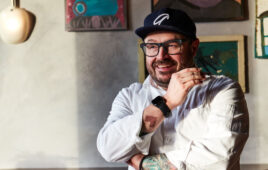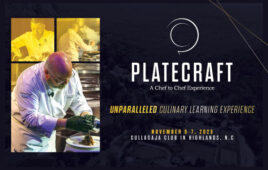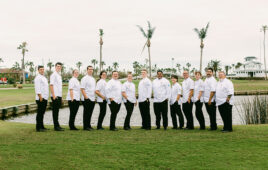 J. R. Thomas
CHEF PROFILE Current Position: |

J . R. Thomas is an extremely rare “species” of club chef. Not only has he only worked in private clubs for his entire career, he’s also worked exclusively for one employer: ClubCorp, the private club management company.
But this has certainly not held him back in terms of culinary achievement or breadth of experience and knowledge. When J. R. recently became Executive Chef of The Citrus Club, a 2,800-member business/athletic club on the 18th floor of The Citrus Center in downtown Orlando, it marked the latest step in an accomplished career that has seen him direct F&B for a variety of prominent ClubCorp properties (see list at left).
As a private club chef by choice, J.R. is living proof that working in our industry is not at all limiting when it comes to developing a wide range of culinary styles. Over the years, he’s developed a passion for Texas/Southwestern (in homage to his native state), fusion and Asian (especially Japanese and Thai) cooking. But a lifelong devotion to the study of all food has given him expertise with a full range of playful, eclectic and ever-changing menus that revolve around using the freshest seasonal ingredients. We are fortunate to have someone with such club-specific insights share his thoughts on how to meet the challenges presented by today’s food and beverage operations:
Q Chef, you’ve worked within a corporate, private-club setting for your entire career. What do you see as the differences between public restaurants and what you’ve experienced?
A In a public restaurant, a ticket prints in the kitchen, food is made, it’s served, and the table is turned. If everything was successful, you may see that customer again.
In a private club, members pay to belong. When the ticket prints in the kitchen, it is handled in totally different fashion, so quality, speed, service and the preferences of our members can be combined to create an experience, and not just a meal, for them and their guests. When we don’t accomplish this, our members tell other members, and the club loses much more than a return customer—we lose our reputation and members’ trust.
Q Can you share how you challenge prospective chefs through the “cook’s test” they must take?
A I give all applicants a three-stage test. First, they need to clean and separate the usable and unusable meat from a 5-up tenderloin, and tell me why. It shows if the cook has worked in a “scratch kitchen” before.
The second part is breaking down a whole salmon; this lets me see if they’ve ever processed fish.
The third involves a “mystery basket”; the only requirements are to use the protein that is provided to prepare a dish for four—one plated, and the other three on a platter. Any other ingredients in the kitchen can be used, and they have a 1-½ hour time frame.
The protein is always an eight-cut, previously roasted chicken. The look that I get when I give them the tray of chicken is one of total confusion, but there is a reason. If I gave them a piece of tenderloin, I’m sure they could make me a tasty steak…who couldn’t? But how many will turn the protein into something else?
Passing the test is easy, but most young culinarians are nervous and usually just reheat the pieces of chicken. If the cook were to make chicken pot pie, a la king, soup, salad or even a stir-fry, it would show me they can utilize all of the ingredients available and think outside the box, to maximize production and save cost.
Q Can you tell us about your commitment to cross-training and mentoring young talent?
A I look at it simply like this: The more knowledge I pass to my cooks, the more talented and valuable they become for themselves and my members. I move cooks around to different stations every couple of months. I also hold C.I.T. (Chef in Training) classes on Monday nights when the club is closed. We do specialty classes on techniques and indigenous cuisines, and go on field trips to see how our vendors handle our produce, seafood, specialty items and meat. Currently, we are trying to schedule a “carcass breakdown” demo [with a purveyor]. This will allow my cooks to have a better knowledge of where all of the cuts of beef physically come from on the cow. These classes also help fuel creativity and excitement about coming to work.
Q The Citrus Club does a strong wedding business; what positive effect does this have?
A In the private club world, I consider a la carte a “tool” for making members and their guests happy. Catering private parties is our bread and butter. We generally cater 60-plus wedding receptions a year. The strong margin on special-occasion menus makes up for loss of revenue on any member event.
Q How have the unique menu items you’ve introduced been received at The Citrus Club?
A I deliver quality food from a scratch kitchen with a very quirky sense of humor attached. While that sounds great, a small portion of my membership is a bit more traditional and resistant to change. It will take some work to get them to try our new menus. But offering the same style of food, and not changing with new members’ demands, will only make us extinct. C&RB
Q Chef, you are very concerned about the environment and what you put on the plate. Talk about how you monitor fish choices, for instance.
A The Monterey Bay Aquarium has a great fish conservation program that educates the average person on how fish is caught or farmed, and the benefits or drawbacks of both. There are some amazing fish in our oceans that give us great flavor and impact for our members, but the more popular the fish becomes, the harder the impact on the environment. As chefs we need to feature fish that are regulated, so we don’t harm the species or feature fish that are farmed in a manner not to harm the environment or us. There needs to be more attention paid to the balance of life and the needs of our future generations.




